Task : Plot the results of a multiple regression (z = f(x, y) ) as a two dimensional plane on a 3D graph (as I can using OSX’s graphing utility, for example, or as implemented here Plot Regression Surface with R).
After a week searching Stackoverflow and reading various documentations of matplotlib, seaborn and mayavi I finally found Simplest way to plot 3d surface given 3d points which sounded promising. So here is my data and code:
First try with matplotlib:
shape: (80, 3)
type: <type 'numpy.ndarray'>
zmul:
[[ 0.00000000e+00 0.00000000e+00 5.52720000e+00]
[ 5.00000000e+02 5.00000000e-01 5.59220000e+00]
[ 1.00000000e+03 1.00000000e+00 5.65720000e+00]
[ 1.50000000e+03 1.50000000e+00 5.72220000e+00]
[ 2.00000000e+03 2.00000000e+00 5.78720000e+00]
[ 2.50000000e+03 2.50000000e+00 5.85220000e+00]
……]
import matplotlib
from matplotlib.ticker import MaxNLocator
from matplotlib import cm
from numpy.random import randn
from scipy import array, newaxis
Xs = zmul[:,0]
Ys = zmul[:,1]
Zs = zmul[:,2]
surf = ax.plot_trisurf(Xs, Ys, Zs, cmap=cm.jet, linewidth=0)
fig.colorbar(surf)
ax.xaxis.set_major_locator(MaxNLocator(5))
ax.yaxis.set_major_locator(MaxNLocator(6))
ax.zaxis.set_major_locator(MaxNLocator(5))
fig.tight_layout()
plt.show()
All I get is an empty 3D coordinate frame with the following error message:
RuntimeError: Error in qhull Delaunay triangulation calculation: singular input data (exitcode=2); use python verbose option (-v) to see original qhull error.
I tried to see if I could play around with the plotting parameters and checked this site http://www.qhull.org/html/qh-impre.htm#delaunay, but I really cannot make sense of what I am supposed to do.
Second try with mayavi:
Same data, divided into 3 numpy arrays:
type: <type 'numpy.ndarray'>
X: [ 0 500 1000 1500 2000 2500 3000 ….]
type: <type 'numpy.ndarray'>
Y: [ 0. 0.5 1. 1.5 2. 2.5 3. ….]
type: <type 'numpy.ndarray'>
Z: [ 5.5272 5.5922 5.6572 5.7222 5.7872 5.8522 5.9172 ….]
Code:
from mayavi import mlab
def multiple3_triple(tpl_lst):
X = xs
Y = ys
Z = zs
# Define the points in 3D space
# including color code based on Z coordinate.
pts = mlab.points3d(X, Y, Z, Z)
# Triangulate based on X, Y with Delaunay 2D algorithm.
# Save resulting triangulation.
mesh = mlab.pipeline.delaunay2d(pts)
# Remove the point representation from the plot
pts.remove()
# Draw a surface based on the triangulation
surf = mlab.pipeline.surface(mesh)
# Simple plot.
mlab.xlabel("x")
mlab.ylabel("y")
mlab.zlabel("z")
mlab.show()
All I get is this:
If this matters, I am using the 64 bit version of Enthought's Canopy on OSX 10.9.3
Will be grateful for any input on what I am doing wrong.
EDIT: Posting the final code that worked, in case it helps someone.
'''After the usual imports'''
def multiple3(tpl_lst):
mul = []
for tpl in tpl_lst:
calc = (.0001*tpl[0]) + (.017*tpl[1])+ 6.166
mul.append(calc)
return mul
fig = plt.figure()
ax = fig.gca(projection='3d')
'''some skipped code for the scatterplot'''
X = np.arange(0, 40000, 500)
Y = np.arange(0, 40, .5)
X, Y = np.meshgrid(X, Y)
Z = multiple3(zip(X,Y))
surf = ax.plot_surface(X, Y, Z, rstride=1, cstride=1,cmap=cm.autumn,
linewidth=0, antialiased=False, alpha =.1)
ax.set_zlim(1.01, 11.01)
ax.set_xlabel(' x = IPP')
ax.set_ylabel('y = UNRP20')
ax.set_zlabel('z = DI')
ax.zaxis.set_major_locator(LinearLocator(10))
ax.zaxis.set_major_formatter(FormatStrFormatter('%.02f'))
fig.colorbar(surf, shrink=0.5, aspect=5)
plt.show()

